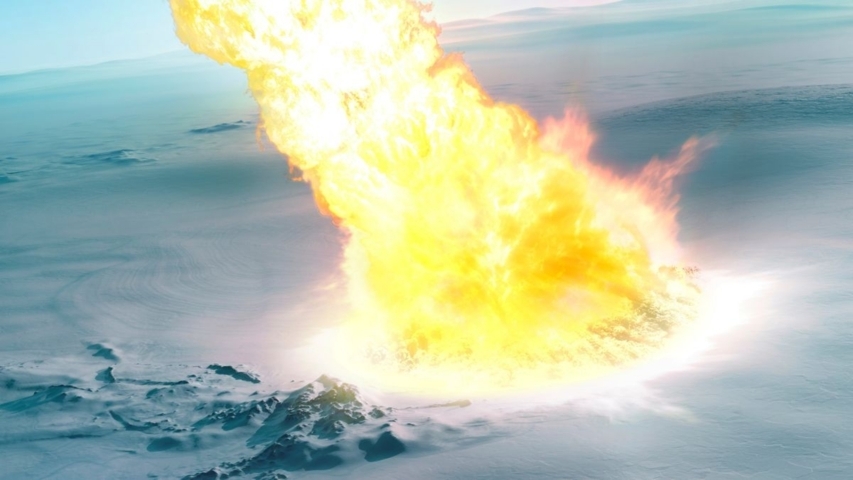Antarctica Got Blasted by a Powerful ‘Airburst’ Event 430,000 Years Ago
Asteroids that smash directly into Earth’s surface can cause extensive damage, but, as new evidence uncovered in east Antarctica suggests, asteroids that explode on entry can be equally devastating.
Super tiny black balls made from igneous rock are evidence of a calamitous event in the Sør Rondane Mountains of Antarctica some 430,000 years ago, according to research published today in Science Advances. An object measuring somewhere from 330 to 490 feet (100 to 150 meters) wide entered our planet’s atmosphere, but instead of crashing on the surface and forming a crater, the object exploded prior to reaching the ground.
Now, that might sound like a good thing, but as geochemist and planetary scientist Matthias van Ginneken pointed out in an email, this “airburst” event still managed to ravage the icy Antarctic surface.
When the object exploded, it produced a “cloud of superheated gas” that resulted from the “vaporization of the asteroid during atmospheric entry,” explained van Ginneken, the lead author of the study and a research associate from the University of Kent in the United Kingdom. This cloud, packed with tiny molten particles and scorching-hot vapor, traveled as a jet and at hypervelocity speeds, as “it did not have time to lose momentum upon reaching the Antarctic ice sheet,” he said. When this jet reached the surface, it was still moving at speeds approaching several miles per second.
No crater was formed from this event, but the contact area—the region that came into contact with the cloud of superheated gas—was blasted into a hellscape, as temperatures reached several thousand degrees Fahrenheit.
“It means that anything standing directly under its way would have been vaporized,” explained van Ginneken. “In addition to that, an enormous shockwave resulted from the explosion of the asteroid close to the ground,” he said, adding that, should a similar event occur over an inhabited area today, “it would be disastrous and extremely destructive over several hundreds of kilometers.”
G/O Media may get a commission
Indeed, we tend to think of asteroids as posing threats only if they hit the surface, but this ancient event in Antarctica serves as a scary reminder of the catastrophic potential of airbursts. As van Ginneken pointed out, “airbursts are a hazard that should not be ignored, mainly because these are much more frequent than crater-forming impacts resulting from much larger asteroids.”
We know of at least two airburst events in recent history, both of which were significantly weaker than the one newly documented in Antarctica. The famous Tunguska event of 1908 is the most notable example, in which an exploding asteroid flattened tens of millions of trees across 830 square miles (2,150 square kilometers) of Siberia. In 2013, an asteroid exploded over Chelyabinsk, Russia, frightening the population and shattering windows across a wide area.
That said, scientists have struggled to identify other historical examples of these calamitous events owing to the lack of visible evidence, namely discernible impact craters. The challenge is to locate the remnants of airburst events in the geological record.
The search for this elusive evidence led van Ginneken, along with co-author Steven Goderis from the Vrije Universiteit Brussel and Alain Hubert from the Princess Elisabeth Antarctic station, to the Sør Rondane Mountains of Antarctica. The trio were members of the 2017-2018 Belgian Antarctic Meteorites expedition, which was funded by the Belgian Federal Science Policy Office and organized with the explicit purpose of hunting for micrometeorites. Most of this research took place when van Ginneken was working at the Royal Belgian Institute of Natural Sciences at the Vrije Universiteit Brussel and the Université Libre de Bruxelles.
The team spent an entire day atop Walnumfjellet mountain, where they sampled glacial sediment from an ancient and glacially eroded surface. Back at the station, “it did not take time for us to find micrometeorites and very unusual looking particles that looked like several spherules fused together at very high temperature,” said van Ginneken, to which he added: “Knowing that these were not micrometeorites but still most likely extraterrestrial, the idea of them resulting from a large meteoritic event seemed a strong probability.”
In total, the scientists found 17 black spherical igneous particles. Using microscopes and laser techniques, they found that the particles measured between 100 and 300 micrometers wide and consisted of the minerals olivine and iron spinel, fused together by small bits of glass. But what made the scientists realize that these particles were alien was their chondritic bulk composition and high nickel content. Indeed, “chondrites are primitive meteorites and are the most common type of meteorites falling on Earth,” explained van Ginneken.
To date the particles, the team paired them with other impact particles previously found in the Antarctic EPICA Dome C and Dome Fuji ice cores, in which a large “meteoritic event was recorded as a thin layer of extraterrestrial dust,” said van Ginneken. These particles, all dating back to the same time period, appear to have formed from a single event some 430,000 years ago.
The new research is important in that it demonstrates a way of searching for meteoric airbursts in the geological record. But it also serves as a reminder of the threat posed by such events. Should something like this happen today over a large city, it would result in millions of casualties, according to van Ginneken.
All the reason to keep searching Earth for signs of previous airbursts, while scanning the skies for potential threats.

